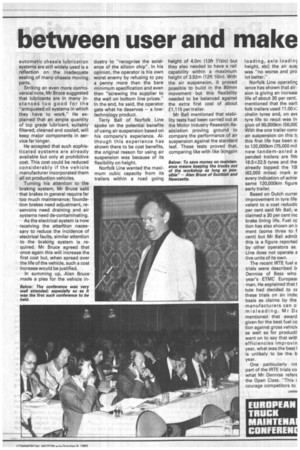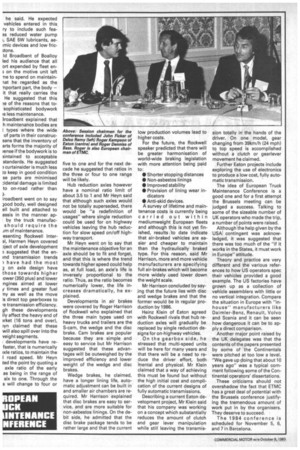between user and make
Page 23

Page 24

If you've noticed an error in this article please click here to report it so we can fix it.
automatic chassis lubrication systems are still widely used is a reflection on the inadequate sealing of many chassis moving parts.
Striking an even more controversial note, Mr Bruce suggested that lubricants are in many instances too good for the "antiquated oil systems in which they have to work." He explained that an ample quantity of top grade lubricant, suitably filtered, cleaned and cooled, will keep major components in service far longer.
He accepted that such sophisticated systems are already available but only at prohibitive cost. This cost could be reduced considerably if the vehicle manufacturer incorporated them all on production vehicles.
Turning his attention to the braking system, Mr Bruce said that brakes in general require far too much maintenance; foundation brakes need adjustment, reservoirs need draining and air systems need de-contaminating.
As the electrical system is now receiving the attention necessary to reduce the incidence of electrical faults, similar attention to the braking system is required. Mr Bruce agreed that once again this will increase the first cost but, when spread over the life of the vehicle, such a cost increase would be justified.
In summing up, Alan Bruce. made a plea for the vehicle in
dustry to "recognise the existence of the silicon chip". In his opinion, the operator is his own worst enemy by refusing to pay a penny more than the bare minimum specification and even then "screwing the supplier to the wall on bottom line prices." In the end, he said, the operator gets what he deserves — a lowtechnology product.
Terry Ball of Norfolk Line spoke on the potential benefits of using air suspension based on his company's experience. Although this experience has shown there to be cost benefits, the original reason for using air suspension was because of its flexibility on height.
Norfolk Line wanted the maximum cubic capacity from its trailers within a road going
height of 4.0m (13ft 11/2in) but they also needed to have a rail
capability within a maximum height of 3.92m (12ft 10in). With the air suspension, it proved possible to build in the 80mm movement but this flexibility needed to be balanced against the extra first cost of about £1,115 per trailer.
Mr Ball mentioned that stabi lity tests had been carried out at the Motor Industry Research Association proving ground to compare the performance of air suspension against the standard leaf. These tests proved that, comparing like with like (kingpin loading, axle loadim height, etc) the air susi was "no worse and pro lot better."
Norfolk Line operating ience has shown that air sion is giving an increasE life of about 30 per cent. mentioned that the earli folk trailers used 11.00x: chelin tyres and, on avE tyre life to recut was in gion of 90,000km (56,00C With the one trailer cony air suspension on this t) this first life has been e: to 120,000km (75,000 mil new tandem-axled a pended trailers are fittr 16.5x22.5 tyres and the already topped the 10( (62,000 miles) mark ar every indication of achie same 120,000km figure early trailer.
Based on Dutch currer improvement in tyre life valent to a cost reductic per cent said Mr Ball, claimed a 30 per cent inc brake lining life. Fuel cc tion has also shown an ir ment (some three to f cent) but Mr Ball admit this is a figure reported by other operators as Line does not operate a tive units of its own.
The recent IRTE fuel e trials were described b. Denniss of Bass who year's ETMC Europear man. He explained that t tute had decided to cE these trials on an indei basis as claims by the manufacturers can o. misleading. Mr DE mentioned that award given for the best fuel co tion against gross vehicIE as well as for producth went on to say that with efficiencies improvin year, what was the best I is unlikely to be the b year.
One particularly int part of the IRTE trials co what Mr Denniss referE the Open Class. "This i courage competitors to he said. He expected vehicles entered in this ry to include such feaas reduced water pump SAE 5W lubricants, aeimic devices and low fric;tons,
Id Broadbent of Boalloy led his audience that all ort expended by fleet en; on the motive unit left -ne to spend on maintainlet he regarded as the riportant part, the body — it that really carries the
He suggested that this le of the reasons that tosophisticated bodywork is less maintenance.
3roadbent explained that h maintenance bodies are t types where the wide of parts in their construeaans that the inventory of arts forms the majority of iense if the bodywork is to 3 intained to acceptable standards. He suggested
curtainsider is much less to keep in good condition se parts are minimised idental damage is limited to on-road rather than 1; ;roadbent went on to say Nod body, well designed ell built and attached to assis in the manner ap
by the truck manufacshould require the J m of maintenance.
esenting Rockwell Inter31, Harmon Heyn covered aject of axle development suggested that the entnd transmission trends have had the most on axle design have those towards higher ower (350 plus) and lower Lngines aimed at lower
times and greater fuel ny as well as the move Is direct top gearboxes to ,e transmission efficiency. gh these developments ily affect the heavy end of 3rket (16 tons and over}, yn claimed that these will also spill over into the veight segments.
developments have refaster, that is numerically txle ratios, to maintain the I road speed. Mr Heyn ted the point by quoting a axle ratio of the early as being in the range of six to one. Through the s will change to four or five to one and for the next decade he suggested that ratios in the three or four to one range will be likely.
Hub reduction axles however have a nominal ratio limit of about 3.5 to 1 and Mr Heyn said that although such axles would not be totally superseded, there would be "a redefinition of usages" where single reduction could be used for on highway vehicles leaving the hub reduction for slow speed on/off high way transport.
Mr Heyn went on to say that the maintenance objective for an axle should be to fit and forget, and that this is where the trend towards higher speed could help as, at full load, an axle's life is inversely proportional to the ratio. Thus, as the ratio becomes numerically lower, the life in creases dramatically, he explained.
Developments in air brakes were covered by Roger Harrison of Rockwell who explained that the three main types used on heavy trucks and trailers are the S-cam, the wedge and the disc brake. Cam brakes are popular because they are simple and easy to service but Mr Harrison suggested that these advantages will be outweighed by the improved efficiency and lower weight of the wedge and disc brakes.
Wedge brakes, he claimed, have a longer lining life, automatic adjustment can be built in and smaller air chambers are required. Mr Harrison explained that disc brakes are easy to service, and are more suitable for non-asbestos linings. On the debit side, he admitted that the disc brake package tends to be rather large and that the current low production volumes lead to higher costs.
For the future, the Rockwell speaker predicted that there will be greater harmonisation of world-wide braking legislation with more attention being paid to: • Shorter stopping distances • Non-asbestos linings 0 Improved stability • Provision of lining wear indicators • Anti-skid devices.
A survey of lifetime and maintenance costs is currently being carried out within mediumweight European fleets and although this is not yet finished, results :to date indicate that air-braked vehicles are easier and cheaper to maintain than the hydraulically braked type. For this reason, said Mr Harrison, more and more vehicle manufacturers are specifying full air-brakes which will become more widely used lower down the weight scale.
Mr Harrison concluded by saying that the future lies with disc and wedge brakes and that the former would be in regular production by 1986.
Heinz Klein of Eaton agreed with Rockwell rivals that hub reduction axles will gradually be replaced by single reduction designs for on-highway vehicles.
On the gearbox side, he stressed that multi-speed units will be here for many years and that there will be a need to reduce the driver effort, both mental and physical. Mr Klein claimed that a way of achieving this must be found but without the high initial cost and complication of the current designs of fully automatic transmissions.
Describing a current Eaton development project, Mr Klein said that his company was working on a concept which substantially reduces the amount of clutch and gear lever manipulation while still leaving the transmis sion totally in the hands of the driver. On one model, gear changing from 39km/h (24 mph) to top speed is accomplished without a clutch or gearlever movement he claimed.
Further Eaton projects include exploring the use of electronics to produce a low cost, fully automatic transmission.
The idea of European Truck Maintenance Conference is a good one and for a first attempt the Brussels meeting can be judged a success. Talking to some of the sizeable number of UK operators who made the trip, a number of points were raised.
Although the help given by the USA contingent was acknowledged, it was suggested that there was too much of the "if it works in the States, it must work in Europe" attitude.
Theory and practice are very different and the various references to how US operators spec their vehicles provided a good example. The US factories have grown up as a collection of vehicle assemblers with little or no vertical integration. Compare the situation in Europe with "inhouse" manufacturers like Daimler-Benz, Renault, Volvo and Scania and it can be seen how dangerous it can be to apply a direct comparison.
Another major point raised by the UK delegates was that the contents of the papers presented by some of the Continentals were pitched at too low a level. "We gave up doing that about 10 years ago" was a typical comment following some of the Continental operators' dissertations.
These criticisms should not overshadow the fact that ETMC has a great deal of potential with the Brussels conference justifying the tremendous amount of work put in by the organisers. They deserve to succeed.
The 1984 conference is scheduled for November 5, 6, and 7 in Barcelona.




































































































